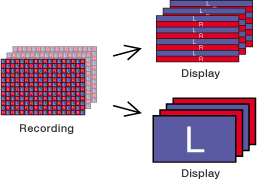In addition to the 3D projection systems for cinemas, a number of different 3D systems have been developed for home TV broadcasting use and also for professional use - in amusement facilities, for in-store displays, for CG/3D production work, and for medical applications. Depending on future technical and market developments, the potential applications for 3D could expand greatly in the years ahead.
3D systems for TV broadcasting are of two types, depending on whether special glasses are required or not. The former group consists of two sub-categories, which are being developed independently: one simultaneously overlays left and right images, while the other displays them alternately.
Viewer |
Method |
Technology |
Features |
|---|---|---|---|
Glasses |
Passive type (polarizing filter) |
Xpol® |
|
Anaglyph (red/blue) |
|
||
ColorCode 3-D (amber/blue) |
|
||
Checkerboard |
|
||
Active type (electronic shutters) |
|||
Full HD x 2 channels frame sequential |
|
||
Naked eye |
Parallax barrier |
|
|
Lenticular |
|
When it comes to 3D recording, manufacturers employ different technologies that reflect different approaches to issues of picture quality and cost, depending on whether the target is consumer or professional use.
• LR independent
· MPEG2 and H.264 are already established standards.
· AVC & MVC offer 1.5~2.0 times encoding capacity.

• Side-by-side
· Uses existing transmission channel bandwidth.
· The picture signals for left and right eyes are compressed by 1/2 horizontally and then combined in a side-by-side format.
· Since this can be transmitted in the same way as a conventional TV signal, it is widely used for creating 3D content and for TV broadcasting. In Japan, the 3D broadcasts on the BS11 satellite channel are of this type.

• Frame (field) sequential
· Noticeable flicker.
· Uses existing transmission channel bandwidth.

• Above-below
· Requires frame memory.
· Uses existing transmission channel bandwidth.

• Line-by-line
· The picture signals for left and right eyes are interleaved in alternate lines.
· Widely used for computers equipped with polarizing 3D LCD monitors.

• Checkerboard
· Filter degrades diagonal characteristics, but resolution can be increased through wobulation (shifting pixels).
· High compatibility with the Smooth Picture technology (DLP wobulation) used to increase resolution for projectors.

• Viewing with Xpol®circular polarizing system

3D content recorded using the side-by-side format is converted to line-by-line format inside the TV (or by separate converter) for viewing with Xpol® filter and circular polarizing glasses. This is the same as for the JVC display demonstration.
• Viewing with checkerboard system

<LCD television>3D content recorded using the checkerboard format is converted to line-by-line format inside the TV (or by separate converter) for viewing with Xpol® filter and circular polarizing glasses.
<Plasma television>3D content recorded using the checkerboard format is converted to frame (field) sequential format inside the TV (or by a separate converter) for viewing with shutter-type (active) glasses.
• Viewing full HD x 2 channels frame sequential format

24p or 60i footage is recorded using the full HD x 2 channels frame sequential format. The TV performs I/P conversion and displays at 120p (60p for left, 60p for right); active glasses are used for viewing.
* Xpol® is a registered trademark of Arisawa Manufacturing.



